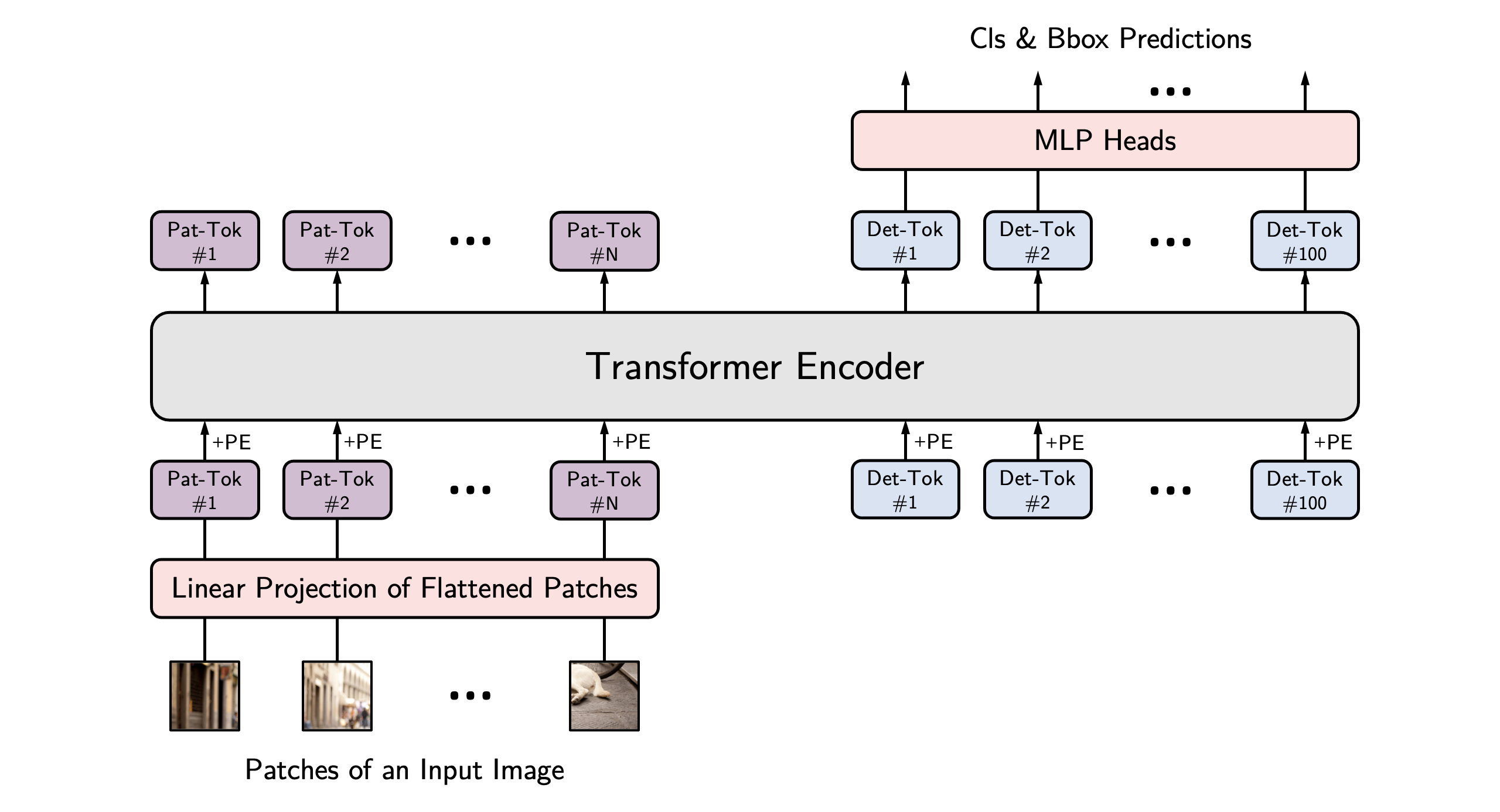-
TL;DR: We study the transferability of the vanilla ViT pre-trained on mid-sized ImageNet-1k to the more challenging COCO object detection benchmark.
-
Code and model weights will be released soon, please stay tuned :)
You Only Look at One Sequence: Rethinking Transformer in Vision through Object Detection
by Yuxin Fang1 *, Bencheng Liao1 *, Xinggang Wang1 📧, Jiemin Fang2, 1, Jiyang Qi1, Rui Wu3, Jianwei Niu3, Wenyu Liu1.
1 School of EIC, HUST, 2 Institute of AI, HUST, 3 Horizon Robotics.
(*) equal contribution, (📧) corresponding author.
arXiv technical report (arXiv yolos.yolos)
Directly inherited from ViT (DeiT), YOLOS is not designed to be yet another high-performance object detector, but to unveil the versatility and transferability of Transformer from image recognition to object detection. Concretely, our main contributions are summarized as follows:
-
We use the mid-sized
ImageNet-1kas the sole pre-training dataset, and show that a vanilla ViT (DeiT) can be successfully transferred to perform the challenging object detection task and produce competitiveCOCOresults with the fewest possible modifications, i.e., by only looking at one sequence (YOLOS). -
We demonstrate that 2D object detection can be accomplished in a pure sequence-to-sequence manner by taking a sequence of fixed-sized non-overlapping image patches as input. Among existing object detectors, YOLOS utilizes minimal 2D inductive biases. Moreover, it is feasible for YOLOS to perform object detection in any dimensional space unaware the exact spatial structure or geometry.
-
For ViT (DeiT), we find the object detection results are quite sensitive to the pre-train scheme and the detection performance is far from saturating. Therefore the proposed YOLOS can be used as a challenging benchmark task to evaluate different pre-training strategies for ViT (DeiT).
-
We also discuss the impacts as wel as the limitations of prevalent pre-train schemes and model scaling strategies for Transformer in vision through transferring to object detection.
| Model | Pre-train Epochs | Backbone | Fine-tune Epochs | Eval Size | YOLOS Checkpoint | AP |
|---|---|---|---|---|---|---|
| YOLOS-Ti | 300 | Deit-Ti | 300 | 512 | yolos_ti.pth | 28.7 |
| YOLOS-S | 300 | Deit-S | 150 | 800 | yolos_s_200_pre.pth | 36.1 |
| YOLOS-S | 200 | Deit-S | 150 | 800 | yolos_s_300_pre.pth | 36.1 |
| YOLOS-S(dWr) | 300 | Deit-S(dwr) | 150 | 800 | yolos_s_dWr.pth | 37.6 |
| YOLOS-B | 1000 | Deit-B (:alembic:) | 150 | 800 | yolos_base.pth | 42.0 |
This codebase has been developed with python version 3.6, PyTorch 1.5+ and torchvision 0.6+:
conda install -c pytorch pytorch torchvision
Install pycocotools (for evaluation on COCO) and scipy (for training):
conda install cython scipy
pip install -U 'git+https://github.com/cocodataset/cocoapi.git#subdirectory=PythonAPI'
Download and extract COCO 2017 train and val images with annotations from http://cocodataset.org. We expect the directory structure to be the following:
path/to/coco/
annotations/ # annotation json files
train2017/ # train images
val2017/ # val images
To train the YOLOS-Ti model in the paper, run this command:
python -m torch.distributed.launch \
--nproc_per_node=8 \
--use_env main.py \
--coco_path /path/to/coco
--batch_size 2 \
--lr 5e-5 \
--epochs 300 \
--backbone_name tiny \
--pre_trained /path/to/deit-tiny.pth\
--eval_size 512 \
--init_pe_size 800 1333 \
--output_dir /output/path/box_model
To train the YOLOS-S models in the paper, run this command:
# pretrained 200 epoch python -m torch.distributed.launch \ --nproc_per_node=8 \ --use_env main.py \ --coco_path /path/to/coco --batch_size 1 \ --lr 2.5e-5 \ --epochs 150 \ --backbone_name small \ --pre_trained /path/to/deit-small-200epoch.pth\ --eval_size 800 \ --init_pe_size 512 864 \ --mid_pe_size 512 864 \ --output_dir /output/path/box_model # pretrained 300 epoch python -m torch.distributed.launch \ --nproc_per_node=8 \ --use_env main.py \ --coco_path /path/to/coco --batch_size 1 \ --lr 2.5e-5 \ --epochs 150 \ --backbone_name small \ --pre_trained /path/to/deit-small-300epoch.pth\ --eval_size 800 \ --init_pe_size 512 864 \ --mid_pe_size 512 864 \ --output_dir /output/path/box_model
To train the YOLOS-S(dWr) model in the paper, run this command:
python -m torch.distributed.launch \
--nproc_per_node=8 \
--use_env main.py \
--coco_path /path/to/coco
--batch_size 1 \
--lr 2.5e-5 \
--epochs 150 \
--backbone_name fa_deit_small \
--pre_trained /path/to/deit-small-dWr-scale.pth\
--eval_size 800 \
--init_pe_size 512 864 \
--mid_pe_size 512 864 \
--output_dir /output/path/box_model
To train the YOLOS-B model in the paper, run this command:
python -m torch.distributed.launch \
--nproc_per_node=8 \
--use_env main.py \
--coco_path /path/to/coco
--batch_size 1 \
--lr 2.5e-5 \
--epochs 150 \
--backbone_name base \
--pre_trained /path/to/deit-base.pth\
--eval_size 800 \
--init_pe_size 800 1344 \
--mid_pe_size 800 1344 \
--output_dir /output/path/box_model
To evaluate YOLOS-Ti model on coco, run:
python main.py --coco_path /path/to/coco --batch_size 2 --backbone_name tiny --eval --eval_size 512 --init_pe_size 800 1333 --resume /path/to/YOLOS-Ti
To evaluate YOLOS-S model on coco, run:
python main.py --coco_path /path/to/coco --batch_size 1 --backbone_name small --eval --eval_size 800 --init_pe_size 512 864 --mid_pe_size 512 864 --resume /path/to/YOLOS-S
To evaluate YOLOS-S(dWr) model on coco, run:
python main.py --coco_path /path/to/coco --batch_size 1 --backbone_name fa_deit_small --eval --eval_size 800 --init_pe_size 512 864 --mid_pe_size 512 864 --resume /path/to/YOLOS-S(dWr)
To evaluate YOLOS-B model on coco, run:
python main.py --coco_path /path/to/coco --batch_size 1 --backbone_name small --eval --eval_size 800 --init_pe_size 800 1344 --mid_pe_size 800 1344 --resume /path/to/YOLOS-B
If you find our paper and code useful in your research, please consider giving a star ⭐ and citation 📝 :
@article{YOLOS,
title={You Only Look at One Sequence: Rethinking Transformer in Vision through Object Detection},
author={All YOLOS Authors},
journal={arXiv preprint arXiv:yolos.yolos},
year={2021}
}